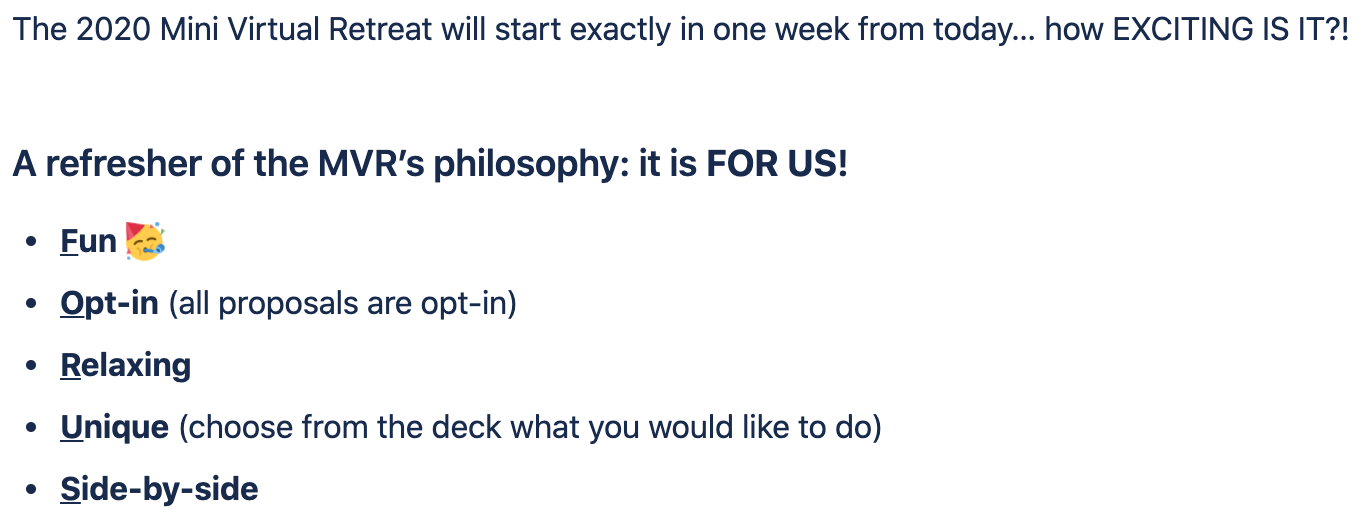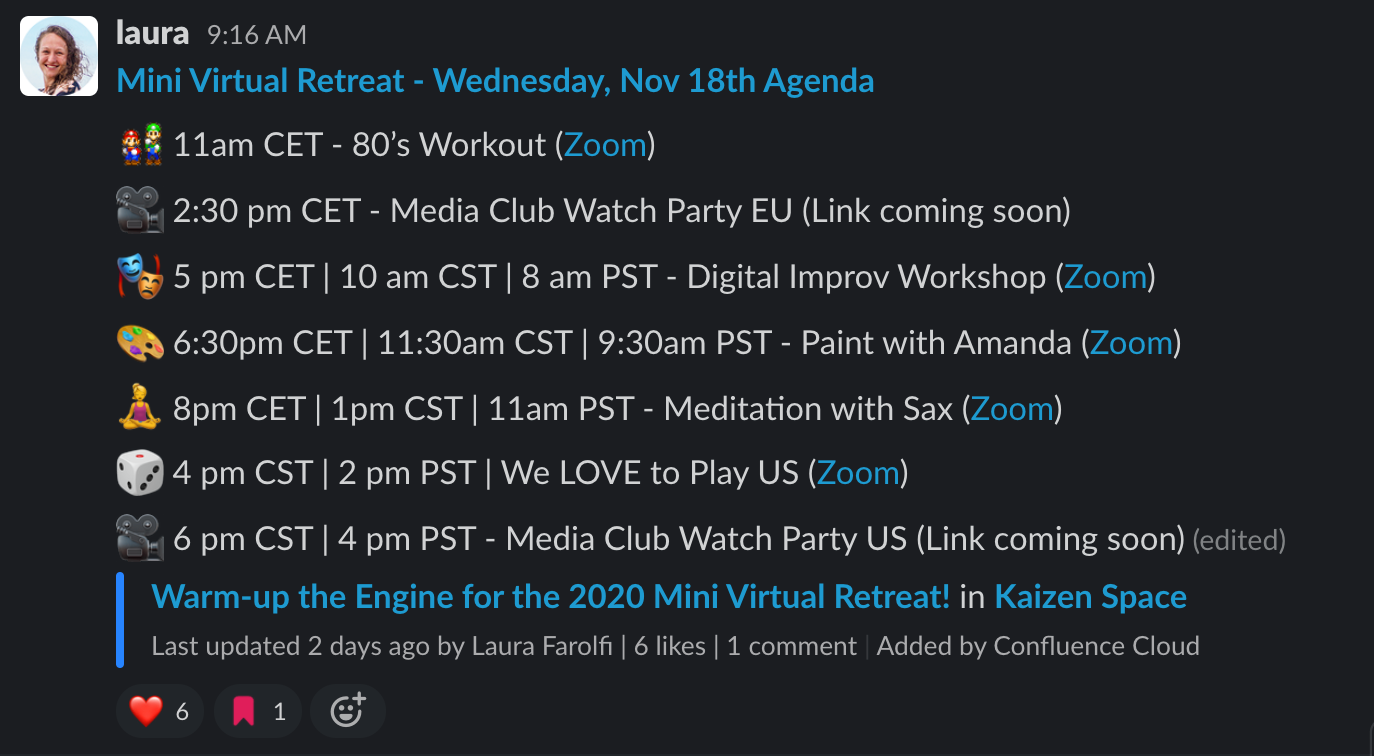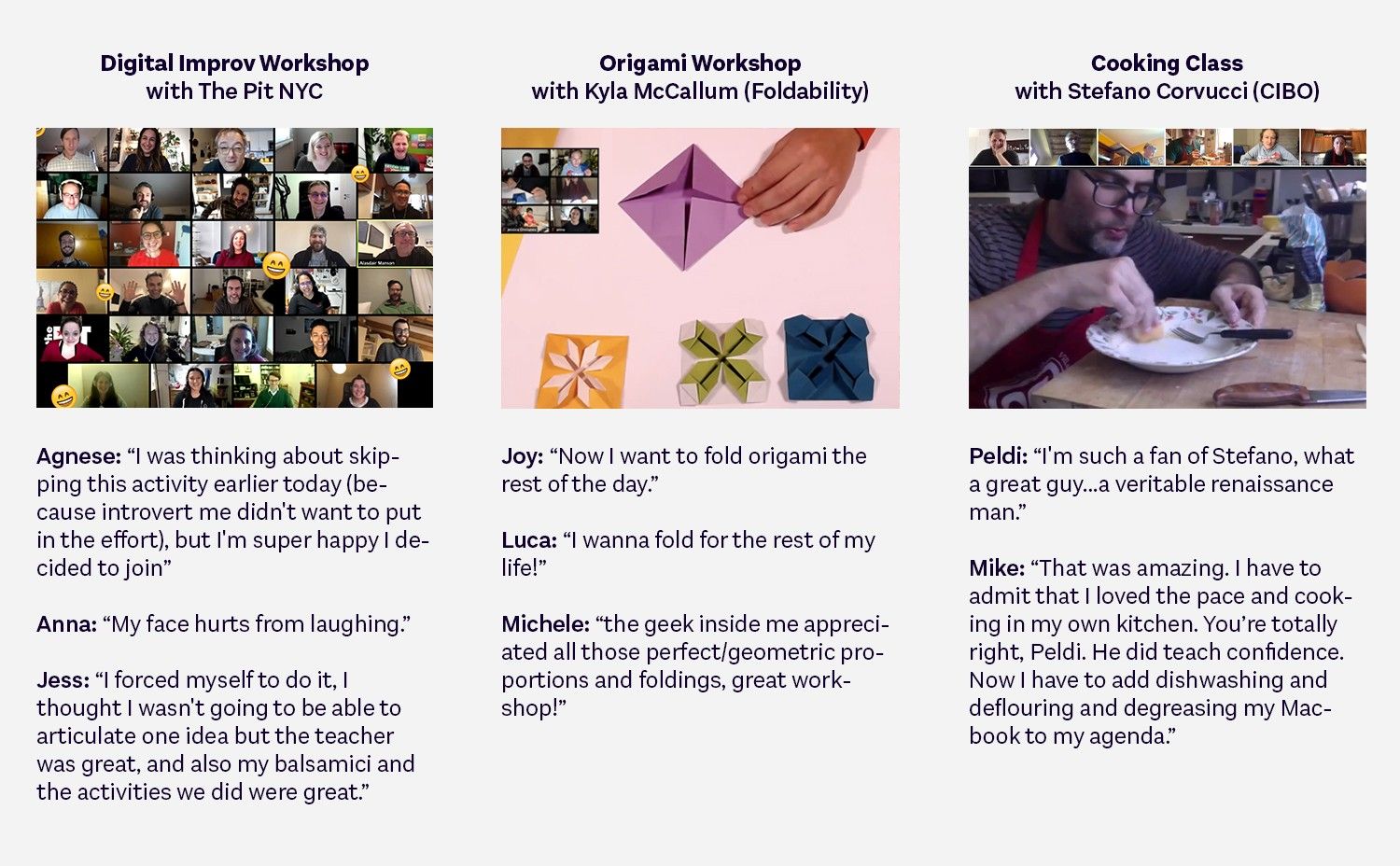“Baking” a Balsamiq Mini Virtual Retreat
Planning an event is not a perfect science. There is not one possible successful outcome. Yes, there are some aspects of the job that are a bit like being good at math: you do the calculation and have a clear single answer. But the truth is, there is more to it than that. You have to balance many different perspectives and make strategic decisions.
It's more like being a chef and managing a restaurant: it’s a creative science.
The menu
We knew what worked perfectly for us during our previous virtual retreat. There was no reason to change out all the elements. As participants had already experienced a successful virtual retreat, we wanted them to feel comfortable and not get lost in unnecessary changes to the format.
We had a goal to make it easy to organize and attend.
On the other hand, this event had implicit elements of newness: it was 3 days only and was dedicated to social time (no “work” sessions were planned). Since we needed to adapt a bit, we decided to have fun adding a few positive changes.

The science: plan the event
When organizing any project, even preparing dinner, you need to manage time, team, communication, resources and procurement, risks, costs, etc. In this sense, planning is more of a science; it’s important to make sure that ingredients aren’t missing, or that the diners don’t eat on the floor because you forgot to buy chairs. 😉
These are some of the methods I followed in planning.
Hire the staff
At Balsamiq we have a long history of teaching one another.
For the May retreat we leaned into the company for the organization of the social moments. We collected ideas, but more importantly, we asked people to fully own their proposals: they had complete responsibility for their timeslot. It proved to be a winning approach.
But conditions were slightly different this time: it was the first year that we had 2 all-company retreats. We could not assume that everyone had the same energy to spend — and we didn’t want to lose good suggestions from someone who didn’t have the skills to teach them.
We changed the call for ideas: people could propose and organize something, or just suggest something. I explored feasibility and helped them organize it or found someone who could. The drawback of doing that is that someone has to make these things happen. Luckily there are professionals you can hire to lead workshops. 🙂
We had great suggestions which we wouldn’t have had with the requirement to lead your own proposal.
We also got “spontaneous nominations” — colleagues nominating others for new things or asking them to again lead activities we had enjoyed at the May retreat.
Order ingredients in advance
For the activities of the May retreat we started collecting proposals one month prior to the event as we were still dealing with a lot of uncertainty due to Covid-19. That timeframe had worked just fine, so we decided to keep it for this event as well.
As the proposals started coming in, we faced new time-related challenges:
- Unlike the May retreat, we hired a few instructors. Finalizing agreements, dealing with tax paperwork, and making payments all take time. The short time window before the event made the process unnecessarily pressured.
- Providing shopping lists for supplies added a slight complexity: especially with Covid-19 restrictions around the globe, we had to rush to provide the list of things to buy.
We made it in time, but we really had to push on the accelerator.
Print the menu
The communications plan didn’t change much: we had the overall event overview on Confluence, each activity had its own descriptive page linked from the official agenda, and a dedicated Slack channel for the event (which was quickly flooded with chitchat, photos, jokes, and party time).
The only addition we made was to make sure that people wouldn’t miss some activities by mistake: I prepared a daily agenda which I shared on Slack every morning.

People appreciated it more than expected. It also helped to set the mood every morning.
The art: balance the agenda and the activities
Once you’ve made sure that all the mandatory planning aspects are taken care of, it’s time to do your balancing and make your menu choices.
Balance the agenda: à la carte vs all you can eat
Something we didn’t change was the structure of the calendar: making the most from the few hours together and adapting around timezones. We scheduled what we considered the retreat highlights during the Golden Hour (when we are all online). We recorded most of the sessions scheduled during the EU mornings and the US afternoons. We selected a mix of synchronous and asynchronous activities and we balanced the “screen time” with time for personal offline activities.
Every activity was opt-in, so we made sure there was enough variety for everyone to find something interesting on the menu, but not so much that people wanting to taste everything were stuck at their computers for 8 hours. We scheduled social-screen-time for 4 or 5 hours a day, and it worked fine. The EU people could do more by joining the US activities and the US by watching the EU recordings.

Balance the activities: a treat and a challenge for everyone
“No work activities” didn’t mean we couldn’t use the time together to learn skills useful for our professional life. Peldi shared his proposal for an activity with a deliberate possible learning outcome:

My first reaction was: “OMG, yes, I’d LOVE that too!”. But I worried about the introverted colleagues. What’s the right balance between learning something outside our comfort zone and simply not having fun?
What is a treat for one person, can be a challenge for someone else.
We moved forward with the idea because we trust the trust we have in one another. We also balanced the improv challenge with something completely opposite: an origami class.
Introducing a new course: learn from one another AND learn together
The biggest element of novelty we added to the retreat was hiring 3 virtual workshop leaders:
- The PIT NY for the Improv Class
- Foldability for the Origami Class
- CIBO for the Cooking Class
We received different and equally good benefits from leading some workshops ourselves and contracting others.
Benefits of Employee-led Workshops:
- Atmosphere: Some games and social gatherings get sillier and more relaxed without an external person present.
- Bonding: Learning about hidden talents and interests is a chance to know one another better.
- Skill development: Teachers learn while teaching, developing ownership and leadership skills.
- Budget: Hiring contractors for every activity can add up!
Benefits of Hiring Workshop Leaders:
- Time and energy: Organizing workshops is time-consuming and requires an investment of energy.
- Expertise: Leading some activities like an Improv class can be challenging and scary. Professionals are used to dealing with these situations, which are especially hard to manage remotely.
- New insights: It’s original and brings a new perspective. For example, during our cooking class with CIBO, Stefano taught recipes some of us already knew, but he also shared lesser-known anecdotes about them.
- Logistics: for some workshops, a professional setup (such as lighting, cameras, audio) is required. Kyla’s (the Origami teacher) use of lighting and the camera set up were extremely professional.

What comes next?
Our Admin Team recently announced that we’ll be having another Full Week Company Virtual Retreat this upcoming May. A full in-person retreat in spring 2021 is not feasible nor socially responsible.
However, May seems so far away, and we liked the Mini Virtual Retreat so much that we are currently brainstorming the idea of a Fun Friday, like a mini-mini social retreat. 😊
Do you have any suggestions for fun activities that helped your team build new mental skills? Did you hire a workshop leader that you’d recommend? We’d love to hear your ideas for things we could consider for our virtual 2021 events!


